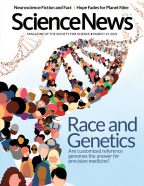This post was originally published on this site

Big mouths to feed
The oldest animal DNA yet recovered comes from a mammoth that lived over 1 million years ago, Erin Garcia de Jesús reported in “Million-year-old mammoth DNA found” (SN: 3/13/21, p. 6).
Considering that a modern elephant can consume hundreds of kilograms of plant food per day, what could the mammoth have eaten in the frozen tundra, reader Peter Nissenson asked.
Researchers don’t know for sure what the ancient animal may have eaten. But like other mammoths, its menu may have included flowers and grasses (SN: 3/22/14, p. 13). Recent studies suggest that dwindling food sources contributed to the demise of most mammoths about 10,000 years ago, Garcia de Jesús says. “So as the flowers disappeared, so too, perhaps, did the mammoths.”
A wild escape
Escaped genes from modified cotton crops are disrupting wild cotton’s interactions with insects, causing irreversible ecological effects, Emiliano Rodríguez Mega reported in “Modified genes may harm wild cotton” (SN: 3/13/21, p. 10).
Reader Marc Sapir wondered why the effects are irreversible if wild cotton plants with the escaped genes struggled more to survive than those without.
Once the genes escape, we can no longer control how they behave or where they go, Rodríguez Mega says. That doesn’t necessarily mean the genes will devastate wild cotton populations. But there currently isn’t a way for scientists to rid those populations of the genes.
The genes could disappear if they are selected against by natural forces, Rodríguez Mega says, but we don’t know that that will happen. More studies are needed to understand the long-term effects the escaped genes could have in the wild.
What makes a plant?
A parasitic plant, Sapria himalayana, has lost genes for stems, roots and photosynthetic tissue to live within its hosts, Jake Buehler reported in “A parasitic plant is missing many genes” (SN: 3/13/21, p. 13).
Given all that S. himalayana has lost, “is it even still a plant?” reader Jeff Fisher asked. Could it be something entirely new?
Biologists group organisms based on their shared evolutionary history, so S. himalayana is still considered a plant, Buehler says. But taxonomists and other researchers have long debated at what point an organism deviates enough from its ancestral line to earn a unique taxonomic rank. There currently isn’t a standard that scientists use to determine these bounds, Buehler says.
Researchers found that the parasite has taken a lot of DNA from its hosts, though much of it doesn’t encode any genes, Buehler reported. Reader D.C. Randle questioned why the plant would bother pilfering this genetic material.
Some of the stolen DNA do encode genes. And those genes may be useful, Buehler says. Some are involved in the parasite’s defense and stress responses, and another is instrumental in making pyrimidine, a crucial building block of nucleic acids like DNA.
Flying high
Microfliers powered by sunlight could fly in conditions like those high in Earth’s atmosphere, Emily Conover reported in “Tiny aircraft that fly by light could soar beyond airplanes’ reach” (SN: 3/13/21, p. 5).
Reader William S. Darter wondered how scalable these microfliers might be.
“The lift forces produced in this case are quite small, so the aircraft and its instruments have to be extremely light,” Conover says. That makes the aircraft a challenge to scale up. “One idea would be to create arrays of microfliers connected by thin carbon fibers. That would allow the microfliers to carry more massive payloads, though still only in the range of grams.”
Correction
“Two new books search for the meaning of life” (SN: 3/27/21, p. 28) incorrectly stated that a person’s metabolism increases to about 0.5 times its resting rate after eating. Metabolism increases to about 1.5 times the resting rate.
